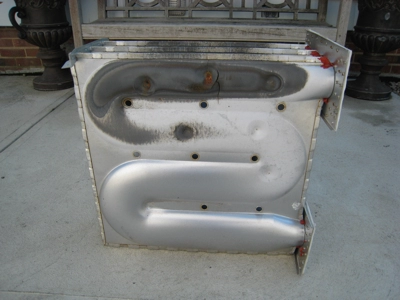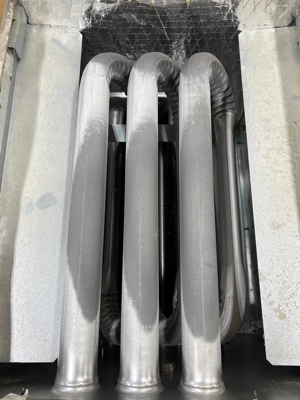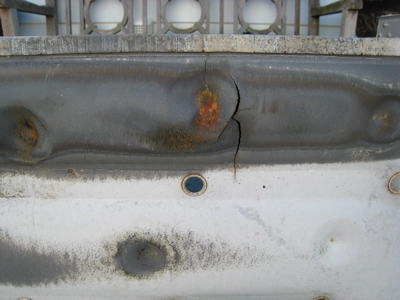It’s true that over time a furnace heat exchanger can crack and trigger a need to replace the entire furnace. But in my 40 years in this industry, a cracked heat exchanger has rarely happened just due to age.
In fact, the three most common reasons for a cracked heat exchanger have often been preventable.
The three most common causes for a cracked furnace heat exchanger are: 1) Oversized equipment 2) Undersized ductwork 3) Lack of maintenance. So how can you prevent these problems?
What Are The Causes For A Cracked Furnace Heat Exchanger?
Oversized HVAC System
Sizing your furnace should be done by an HVAC professional. Unfortunately, like every industry, not everyone in the HVAC field is a professional. And those that aren’t often oversize equipment to cover a lack of knowledge or effort into doing the job right. It’s easy to oversize and most people won’t notice the difference.
But an oversized furnace is not just more expensive upfront but can also cause comfort issues within your home and earlier failure of the heating system.
One of the problems of a furnace that is too big is the constant “short cycling”. Short cycling is a term used to describe when a furnace will turn on and off more frequently than it should. And this “short cycling” causes excessive wear and tear on the furnace.
How To Prevent Oversized Furnaces: Find a good quality contractor that will guarantee their work. A good contractor should have a performance guarantee in their contract. It should be stated clearly that your contractor has calculated the correct size and will replace it for free if it turns out to be incorrect.
Undersized Ductwork
Ductwork that is too small is like asthma. Without the correct amount of air our body will suffer. And just like our body, a furnace needs a certain amount of air coming in and going out or it will suffer.
If the ductwork is undersized, it will restrict the airflow and lead to overheating and an inefficient heating and cooling system.
How To Prevent Cracks From Undersized Ductwork: Again, this one comes down to picking the right contractor. Most new homes built today have ductwork issues. After all, the jobs are being installed by the lowest bidder so you can imagine the quality of work that goes on with behind the scenes items like the HVAC system. But it doesn’t have to stay that way.
Ductwork repairs can be made at any time and a quality contractor will recommend needed improvements to ductwork that could prevent stress cracks on the heat exchanger and improve comfort throughout the home.
Lack of Furnace Maintenance
Neglecting maintenance is a common problem for all kinds of systems. Without having your oil changed at regular intervals, you can probably imagine how poor your car would run. Just as bad as using used, dirty oil is for a car, not taking care of your furnace can be just as damaging to the heat exchanger.
It’s not uncommon for a furnace to be operating outside of how it was designed. Parts fail or need adjustment. When those things are ignored, the furnace can operate in such a way that it does damage to the heat exchanger and causes early failure.
How to Prevent Cracked Heat Exchangers From Lack Of Maintenance: The best way to ensure that your furnace is in good condition and stays that way is by having regular maintenance performed. These tasks include cleaning the filters, testing the vents for corrosion or leaking to avoid carbon monoxide leakage, monitoring the heat exchanger and checking electrical wiring.
Don’t try to do this yourself. Call in a professional. In fact, some aspects of furnace maintenance need some expensive special tools that most homeowners will not own. Special combustion analyzers can really tune a furnace and protect the heat exchanger. These tools can also alert if there’s any chance of carbon monoxide poisoning.
Picking the right kind of filter and making sure it’s kept clean is also very important. A dirty furnace filter causes the system to perform like it has undersized ductwork. The unnecessary wear and tear can damage the furnace and shorten its lifespan by almost half.
What Is A Heat Exchanger In A Furnace?
Heat exchangers are the heart of a gas furnace. They’re used to transfer heat generated by the burning of fuel to the air flowing over them. The air then flows into the home via the ductwork to distribute the heated air.
Depending on the efficiency of your furnace, it could contain one or two heat exchangers.
More efficient style furnaces, like models with an AFUE efficiency rating greater than 90%, will commonly have two heat exchangers. One primary and one secondary.
Anything lower than 90% AFUE will have only one heat exchanger.
A heat exchanger is made up of a series of tubes, a drum or a clamshell design. The secondary heat exchanger will have tubes with fins or plates attached to them, which allow for maximum contact between the heated surfaces and the air.
Heat is transferred from these hot surfaces to the cold air which is then distributed evenly throughout your home through the ductwork system. This process allows for more efficient use of energy than other types of heating systems, as much as 90% efficiency in some cases. The heat exchanger also helps to reduce emissions from gas furnaces by preventing dangerous gases from entering your home’s air supply.
What Happens If Your Furnace Has A Cracked Heat Exchanger?
Unless you are very familiar and trust your HVAC contractor, the first thing you should do if you’ve been told that your furnace has a heat exchanger crack is get a second opinion. False claims of a cracked heat exchanger are often used as a scam on unsuspecting homeowners. In fact, one of my more common calls in the winter is giving someone a second opinion and assuring them that their heat exchanger is just fine.
If the heat exchanger does have a crack or multiple cracks, it’s important to have it repaired immediately. A cracked heat exchanger can be dangerous because it can cause a furnace to start producing high levels of carbon monoxide and allow it to enter the home.
This is just another reason a cracked heat exchanger can be dangerous and to make sure you have a good quality carbon monoxide detector.




I have propane as my fuel. I had a reputable company come in today for cleaning & tune up. There is a great deal of corrosion inside the furnace & the tech found more than one crack in the heat exchanger. I have 2 hard wired combo C02/fire alarms that are just a cpl months old. Im concerned because they are at ceiling height & co2 gas tends to stay low. Am I safe until I am able to get another furnace installed? Thank you
Hi Susan – Carbon monoxide detectors are an important step to staying safe. Here’s an article that will explain placement of CO detectors a little more…
https://thecomfortacademy.com/is-carbon-monoxide-lighter-than-air/
But as far as remaining in the home, your HVAC company should have been able to test if the furnace was making any CO and if there was a possibility of it entering the home. I’d suggest you get in touch with the company again for details of their testing. I’d also suggest you call in another quality HVAC company to get a second opinion.